Steven Spielberg Jurassic Park in 3D
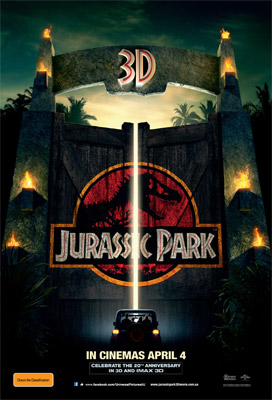
Steven Spielberg Jurassic Park in 3D
Cast: Sam Neill, Laura Dern, Jeff Goldblum, Samuel L. Jackson, Richard Attenborough
Director: Steven Spielberg
Genre: Action, Adventure
Rated: Adventure, Family, Sci-Fi
Running Time: 127 minutes
Synopsis: Universal Pictures will release Steven Spielberg's groundbreaking masterpiece Jurassic Park in 3D. With his remastering of the epic into a state-of-the-art 3D format, Spielberg introduces the three-time Academy Award®-winning blockbuster to a new generation of moviegoers and allows longtime fans to experience the world he envisioned in a way that was unimaginable during the film's original release. Starring Sam Neill, Laura Dern, Jeff Goldblum, Samuel L. Jackson and Richard Attenborough, the film based on the novel by Michael Crichton is produced by Kathleen Kennedy and Gerald R. Molen.
Release Date: April 4th, 2013
3D Conversion Production Information
Welcome back to Jurassic Park.
With the 20th anniversary of one of Universal Pictures' most enduring hits approaching, the studio decided to reissue the film in theatres across the world, approaching theatre owners with the idea of a 3D post-conversion for one of Universal's favourite adventures, stunningly restored in 4K.
As technology shifts and changes the manner in which filmmakers are able to tell stories, 3D has provided the ability to bring audiences into the Jurassic Park that Steven Spielberg was subconsciously shooting. This type of design not only allows for an unexpected, nostalgic journey for those who embraced the film in 1993, it offers the chance for new audiences to take an unexpected ride alongside Stan Winston's and Industrial Light and Magic's (ILM) brilliant creations.
Although an entire generation has watched on the small screen while Lex and Tim outsmart cunning Velociraptors and stared in awe as Dr. Sattler and Dr. Grant stumble upon the herd of graceful Brachiosaurs, they've been unable to wholly immerse in the sights and sounds of the lush and deadly Isla Nublar about which Michael Crichton and David Koepp dreamed. Until now.
As Steven Spielberg collaborated with Stereo D, the team who designed the 3D conversion for Titanic, they went shot by shot through Jurassic Park to figure out how to evolve the movie and expand your senses within a new dimension. Now, when you hear the footfall of T. rex and see the glass of water tremble, wait for the baby raptor to hatch and vault with the Explorer off the barrier, you will feel as if you're entering Jurassic Park for the first time.
Universal hopes that audiences enjoy Jurassic Park in 3D as much as the 700-plus-member team did painstakingly recalibrating it. To our fellow movie lovers, we eagerly await the moment you hear John Williams' epic score bringing us back to where it all began. As adventure seekers and honorary paleontologists, we share in the wonder of dinosaurs roaming the Earth once again…and in the awe of Man being there to greet them.
About the Conversion
When Steven Spielberg originally shot Jurassic Park, his cast and crew were fortunate enough to be surrounded with a stunning 3D backdrop of Stan Winston's dinosaur creations to inspire them on set. Coupled with ILM's ground-breaking CG and the film's dramatic human moments, Jurassic Park naturally lent itself to an immersive experience in conversion.
Whether it was in action-heavy sequences such as the epic Velociraptor/T. rex fight or the thoughtfully quiet scene in which Dr. Sattler and John Hammond talk over ice cream about the ramifications of Hammond's vision, Steven Spielberg framed those original shots to make them feel quite multidimensional. When it came to this process, the director's past choices proved to be of enormous assistance for Stereo D as the studio converted Jurassic Park's content into stereoscopic 3D imagery.
To evolve this epic action-adventure, it took more than 700 artists to isolate each small detail inside of every frame, add depth to the shot and then redimensionalise into 3D to stretch the screen.
Purists fear not! During the conversion, Steven Spielberg was cautious not to significantly alter scenes from or add new sound effects to the original. Rather, the goal was laser-focused format enhancement. Whether it was Spielberg's addition of rain in the foreground when we first see T. rex or splinters breaking toward our eyes as the Explorer hurtles down the tree, his objective was to make us pay attention to what's in front of and behind the camera.
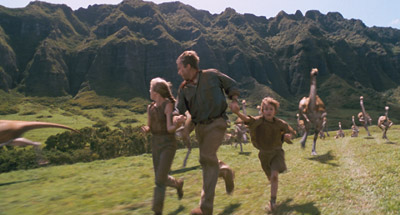 The conversion of Jurassic Park into 3D took nine months to complete. So how did the team do it? Stereo D received assets in the form of original 2D plates and performed an ingest into its proprietary asset and pipeline management system.
The conversion of Jurassic Park into 3D took nine months to complete. So how did the team do it? Stereo D received assets in the form of original 2D plates and performed an ingest into its proprietary asset and pipeline management system. After extensive spotting sessions, Stereo D's Rotoscoping and Depth teams began their work, breaking down and working with the components contained within each frame of the movie. The Depth team utilised Stereo D's proprietary software, VDX. Then, if the shot needed it, the in-house VFX team added 3D augmentation for elements including (but not limited to) smoke, sparks, rain or any type of particle.
Last but not least, Stereo D's paint team added the very final polish to each shot to ensure a beautiful end result by filling in the missing information revealed by making the shots 3D .
With current films, most often the conversion occurs in tandem with the production, and Stereo D receives its elements on an hourly or daily basis. On archival titles such as Jurassic Park, the length of time to convert varies based on many factors"among them: the condition of the original negative, the length of the film and the relative difficulty or detail in the content.
Because such natural elements as rain and leaves in a forest are considered some of the most difficult things to re-create in conversion, Jurassic Park in 3D provided quite an interesting academic exercise for the hundreds of team members. In fact, more raindrops were converted in this movie than have ever been created in 3D, ensuring that our moviegoers will feel like they're knee deep in the adventure with our heroes.
The additional perspective of adding planes of foreground, middle ground and background to Jurassic Park in 3D will make you feel, for example, like you're in the car with Tim and Lex as the T. rex attacks. Indeed, the conversion enhanced the scales on the dinosaurs to the point that you feel like you may and should reach out and touch them.
Bringing moviegoers further into Jurassic Park is just as important audibly as it is visually. The footfall of a T. rex racing toward the audience in 3D would inherently sound more expansive than in 2D, so the sound design team took advantage of today's technology and modern theatres to give the sound greater depth and more dynamics.
For the audience, not only are the mournful lowing of the Brachiosaurs more beautiful than ever, the roars of the angry T. rex are even more terrifying. Interestingly, for the original T. rex roar, the sound designer modified the recording of a baby elephant's yell. Cut and pasted, played backward and stretched, this sound was a layer in the main vocals of our hero dinosaur. To thrust moviegoers into the middle of this 3D scene, the sound was pulled even further toward the audience.
And now let us go back in time, to where it all began.
Jurassic Park Original Production Information: May 7, 1993
'This is not science fiction; it's science eventuality.""Steven Spielberg
'You decide you'll control nature, and from that moment on
you're in deep trouble, because you can't do it.
You can make a boat, but you can't make the ocean.
You can make an airplane, but you can't make the air.
Your powers are much less than your dreams would have you believe." "Michael Crichton
Imagine that you are one of the first visitors to Jurassic Park"a melding of scientific discovery and visual imagination. You arrive as a child would, free of preconceptions and ready for anything. Your adventure is about to begin.
Entering the gates of the park, your senses are overwhelmed by the world that surrounds you; the sounds, the smells, even the feel of the earth is curiously different. Somewhere in the distance, you hear the movement of huge animals"the ground shakes with their passing. You are a stranger in an alien world.
You look into the night sky, at stars whose light was born long before humans ever existed; born when a different race of beings walked the planet–swift, powerful animals, rulers of the earth for 160 million years. Like those ancient stars, the Jurassic has left only faint traces of itself"in fossils, footprints, relics of blood cells encased in amber. A time capsule that has remained closed for countless millennia.
Now the time capsule has been opened, and man and dinosaurs, the two rulers of the earth, will meet for the first time.
All our scientific resources have been dedicated to bringing Jurassic Park to reality; a childhood fantasy made real, a place where wonders come to life. It was created to be the ultimate amusement. But someone forgot to tell the dinosaurs.
Meeting them in their environment, we realise they are not monsters, but animals far more agile, far more intelligent and far more dangerous than we guessed. We can give birth to the dinosaurs, but nothing can prepare us for what will happen when the egg hatches.
Jurassic Park is the place where science ends and the unpredictable begins.
Directed by Steven Spielberg from the best-selling book by Michael Crichton, Jurassic Park stars Sam Neill as Dr. Alan Grant, a renowned paleontologist who is asked to inspect a spectacular amusement park; Laura Dern as his colleague, Dr. Ellie Sattler; Jeff Goldblum as a brilliant but eccentric mathematician whose Chaos Theory explains the dangers inherent in the project; and Sir Richard Attenborough as John Hammond, the park's ambitious developer. Ariana Richards and Joseph Mazzello are Hammond's young grandchildren. Also starring are Bob Peck, Martin Ferrero, B.D. Wong, Samuel L. Jackson and Wayne Knight.
Kathleen Kennedy and Gerald R. Molen produce the Amblin Entertainment Production for Universal Pictures. Lata Ryan is associate producer. Michael Crichton and David Koepp wrote the screenplay. Behind the cameras, the creative team includes cinematographer Dean Cundey, production designer Rick Carter and editor Michael Kahn.
In addition to the talented cast of actors, Jurassic Park features stars of a different magnitude. For more than 18 months before filming began, an award-winning design team had been conceiving and creating the live action dinosaurs that would inhabit the unique park. From the huge Tyrannosaurus rex to the vicious Velociraptor, Jurassic Park features a level of realism and technical innovations never before captured on film.
About the Production
In May of 1990, Universal obtained the galleys of best-selling author Michael Crichton's upcoming book 'Jurassic Park," and within a matter of hours, the studio was intently negotiating to purchase the book on behalf of Steven Spielberg.
'It was one of those projects that was so obviously a Steven Spielberg film," says producer Kathleen Kennedy, who has closely collaborated with the filmmaker for 14 years. 'If you look at the body of Steven Spielberg's work, he very often is interested in the theme of extraordinary things happening to ordinary people."
'What's interesting to me about this particular project is there is as much science as there is adventure and thrills," says Steven Spielberg. 'Jurassic Park is a cross between a zoo and a theme park. It's about the idea that man has been able to bring dinosaurs back to earth millions and millions of years later, and what happens when we come together."
Author Michael Crichton, who spent two years writing the book, witnessed a flurry of bids and negotiations from four major studio contenders, but was pleased to learn of Steven Spielberg's interest in directing the film. In less than a week, Universal announced that Jurassic Park would be directed by the filmmaker who had so successfully blended art and science in the making of such films as Close Encounters of the Third Kind and E.T. The Extra-Terrestrial.
Michael Crichton's remarkable background as a graduate of Harvard Medical School, novelist, screenwriter and film director had led to his distinct flair for techno-thrillers such as 'The Andromeda Strain" and 'The Terminal Man." The story that had been percolating about a theme park for genetically engineered dinosaurs grew out of his concern for the rise of 'scientism." 'I believe that science is a wonderfully powerful, but distinctly limited tool," says Michael Crichton.
Envisioning the park's billionaire developer John Hammond, as a sort of 'dark Walt Disney," Michael Crichton's story ventured into an area of growing controversy–biogenetics for the sake of profit.
'There's a big moral question in this story," says Steven Spielberg. 'DNA cloning may be viable, but is it acceptable? Is it right for man to do this, or did dinosaurs have their shot a million years ago?"
A self-professed dinosaur fan since childhood, Steven Spielberg recalls, 'The first big words I ever learned were different dinosaur species, and when my son Max was two years old, he could not only identify but pronounce -Iguanadon.'
'I think one of the things that interests kids is that they're so mysterious. There's a quote from a Harvard psychologist who was asked why kids love dinosaurs so much. He said, -That's easy. They're big, they're fierce and they're dead."
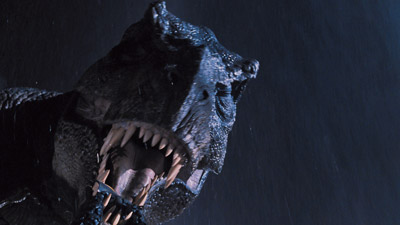 'But now they're back," chuckles Steven Spielberg. Both Michael Crichton and Steven Spielberg view paleontology as detective work, a Sherlock-Holmes-like deductive existence.
'But now they're back," chuckles Steven Spielberg. Both Michael Crichton and Steven Spielberg view paleontology as detective work, a Sherlock-Holmes-like deductive existence.
'When I first saw a dinosaur dig, it looked just like the scene of a crime," recalls Steven Spielberg. 'It had ribbons around it, with people working as if they were forensic scientists brushing for fingerprints. I'd love to spend a summer in Montana doing that."
It was the summer of 1990, that Kennedy and Steven Spielberg first began to recruit the 'dream team" that would lay the creative foundation for 'Jurassic Park." First on board was talented production designer Rick Carter, who did Back to the Future Part II and III. His first association with Amblin began when he designed 42 episodes of Amazing Stories.
As Michael Crichton began adapting his complex book into a feature-length screenplay, Rick Carter started work with a group of illustrators and storyboard artists who could help translate Michael Crichton's words into cinematic images. Rick Carter's goal was to find a convincing blend of science, fantasy and reality that he likened to Close Encounters of a Prehistoric Kind.
One of the movie's challenges would be narrowing Michael Crichton's 15 dinosaur species down to a more practical six. Next, there was research to be done as to how the dinosaurs would move on film. Associate producer Lata Ryan joined the company in September of 1990 with the challenge of helping to build an all-star effects team that would bring the dinosaurs to life. In the months ahead, Lata Ryan became a choreographer whose formidable task was to serve as a source of communication and clarification for the four separate effects units.
Historically, the action of large creatures had been best achieved with old fashioned stop-motion photography, but Steven Spielberg had hopes of pushing the effects envelope and developing technologies that had not been used before. After a thorough interview process with every effects shop in town, the producers selected a cadre of effects people who were literally challenged to go where no man had gone before.
Kennedy recalls, 'It was a dream come true to land Stan Winston, Phil Tippett, Dennis Muren and Michael Lantieri all on one movie."
Stan Winston Studio was asked to create the live action dinosaurs; full-size animals who would be both quick and mobile. A miracle worker in both make-up and creature effects who had been acclaimed for his work on such notable films as The Terminator, Aliens and Terminator 2, Stan Winston broke the project into three phases: research, design and construction.
Dedicated to making dramatic characters that are both spectacular and majestic, Stan Winston and his team spent a full year in the research phase. Consulting with paleontologists, museums and hundreds of texts, Stan Winston's artists prepared detailed sketches and renderings that would later lead to fifth-scale sculptures, and finally, to such enormous creations as a 20-foot Tyrannosaurus rex.
In order to tackle the scope and breadth of the project ahead, Stan Winston designated a group of teams that included both artists and engineers. To give you an idea of each team's complex responsibilities, meet 'Team rex," which consisted of 12 operators performing widely varying functions. Constructed from a frame of fiberglass and 3,000 pounds of clay, the 20-foot tall T. rex was covered with a durable yet delicate latex skin and then painted by a team of artists who blended a rich palette of colours to bring his body to life. The T-rex was then mounted on a 'dino-simulator," an imaginative mechanism inspired by hydraulic technology and based on a traditional six-axis flight simulator used by the military. On this motion-based foundation, both the platform and the T. rex could be actuated through a computer control board.
Meanwhile, a fifth-scale version of the T. rex, resembling an elaborate erector set, had been built so that the identical motion of the scaled down armature could be generated manually by four puppeteers. Once the small T. rex (called a Waldo) had rehearsed the moves and actions required in a specific scene, a computer recorded the movement and programmed the big T. rex to repeat the action exactly. While the Waldo's puppeteers operated the animal's head, torso, tail and arms, additional puppeteers crouched nearby to simultaneously operate the T. rex's eyes, mouth, jaw and claws.
The Stan Winston Studio, which employed more than 60 artists, engineers and puppeteers in the making of Jurassic Park, also created life-sized, articulated versions of a 20-foot Tyrannosaurus rex, a 6-foot tall Velociraptor, the long-necked Brachiosaurus, a sick Triceratops, a Gallimimus, the unusual Dilophosaurus (aka 'the Spitter") and a baby Raptor hatchling.
With the challenge of creating 'live" dinosaurs solved by Stan Winston, Steven Spielberg turned his attentions to the necessity of miniature photography for the wide angle or full length shots. He took his thoughts to Phil Tippett, an Academy Award winning animator and effects wizard who devised the Go-Motion System (a much refined version of stop-motion) while working on the film. Phil Tippett, who formerly worked for ILM, is based in Berkeley, California and Dragonslayer eagerly began recruiting a team that would supply more than 50 Go-Motion shots.
In addition to choreographing the movements of the dinosaurs on film, Phil Tippett was also relied on to provide a series of 'animatics," as a means of helping the filmmakers to prepare and rehearse the highly complex scenes with T. rex and the Velociraptors.
Early in the process, Steven Spielberg had also consulted with Industrial Light and Magic, the effects house founded by George Lucas which had collaborated with him on many films. ILM's effects supervisor Dennis Muren, a six-time Academy Award® winner, was anxious to participate in Jurassic Park, but since Steven Spielberg hoped to use full scale dinosaurs and Go-Motion, he was unclear about ILM's role in the project.
But a year later, when Steven Spielberg was working closely with ILM as the director of Hook, a new conversation began. As the industry leaders in the area of computer graphics for film, ILM had only recently devised ground-breaking computer generated imagery and astonishing morphing techniques in the making of Terminator 2: Judgment Day. Members of the ILM computer graphics team quietly experimented with an idea for Jurassic Park"they built the bones and skeleton of a dinosaur in a computer, and from that, they created a walk cycle for the T. rex.
Impressed with the test results, Amblin Entertainment soon gave ILM the greenlight to take on several additional shots, including a stampede and several wide-angle scenes that illustrate a herd of dinosaurs against a sweeping vista. When Dennis Muren next returned to Amblin, he astounded the filmmakers with a computer-generated sequence of the T. rex walking in daylight. It appeared that with the advent of computer-generated images, Go-Motion might soon be extinct.
Although Phil Tippett's work was ultimately reassigned to ILM, Phil Tippett became a valuable member of the 'transition team" and set up training sessions with ILM's graphic designers to teach them as much as possible about character movement throughout the production.
Michael Lantieri, who headed the fourth effects unit, had a long association with Amblin projects; he had worked with Robert Zemeckis on Who Framed Roger Rabbit? and Back to the Future Part II and III, and had collaborated with Spielberg on Indiana Jones and the Last Crusade and Hook. His team would be responsible for a myriad of mechanical challenges including the construction of exterior cranes and large scale hydraulics that would move the enormous dinosaurs around. Michael Lantieri's group was also responsible for a number of imaginative camera riggings that were customised to move fluidly with Stan Winston's creations.
During the two years of pre-production on Jurassic Park, there wasn't an idle moment for Steven Spielberg, Kennedy or producer Jerry Molen, who simultaneously undertook the making of Hook, an imaginative dramatic adventure based on the story of Peter Pan.
Meanwhile, work continued on the screenplay, beginning with Michael Crichton's first draft. Later, David Koepp, the young screenwriter who had co-written the black comedy Death Becomes Her, was brought on to the project, and he shares the screen credit with Crichton. 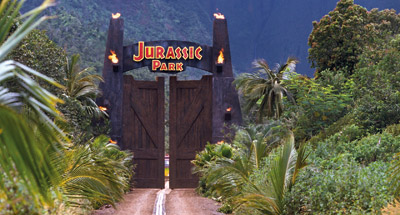 Construction was now underway in Hollywood on two of Universal's largest sound stages, and would later expand to three others on the lot, as well as one enormous sound stage at Warner Bros. Studios.
Construction was now underway in Hollywood on two of Universal's largest sound stages, and would later expand to three others on the lot, as well as one enormous sound stage at Warner Bros. Studios.
Casting was a relatively short process, capped by the signing of Sir Richard Attenborough, whose acclaimed work as a film director had distracted him from acting roles since 1979.
'I think Steven Spielberg is a genius," says David Attenborough, who had recently completed directing 'Chaplin." 'And he has asked me on a number of occasions in the past to work for him. After I read the book, I thought if any man in the world can make a movie of this, it's Steven Spielberg."
Starring as Dr. Alan Grant is Sam Neill, portraying a renowned paleontologist who is none too pleased to be touring Jurassic Park with two rambunctious children. Laura Dern portrays Dr. Ellie Sattler, a paleobotanist who is both a colleague and love interest of Dr. Grant's. Jeff Goldblum, dressed in black from head to toe, is Ian Malcolm, the eccentric mathematician who predicts doom for the Park.
When Jurassic Park began principal photography on the island of Kauai on August 24, 1992, it had been exactly two years and one month since the start of preproduction. The lush green resort-land near Lihue was an ideal setting for the Jurassic Park exteriors, but after three weeks of filming under the tropical sun, a real-life drama over-shadowed the movie.
Hurricane Iniki was fast approaching Kauai, and the crew was asked by the hotel to pack their suitcases and fill their bathtubs with water in case of future power and water shortages. Next, they were instructed to pack a day bag and meet in the ballroom of the hotel on the basement level.
By 9:00 a.m. the storm was headed straight for the island. Kathy Kennedy recalls, 'We started pulling all our supplies into the ballroom, and the camera crew was quickly packing their things in the trucks. But if you're going to be stranded with anyone, be stranded with a movie crew," says Kathy Kennedy. 'We had generators for lights, and plenty of food and water. We were self-sustaining because we moved around on location all the time."
Camped out in rows of chaise lounges on the ballroom floor, the cast and crew heard the winds pick up at about 4:00 p.m. and rumble by at almost 120 mph. 'It sounded like a freight train roaring past the building," recalls the producer.
When water seeped into one end of the ballroom, the crew huddled on the other side of the room. But at 7:30 p.m., Kathy Kennedy and Gary Hymes, the stunt coordinator, stepped outside into silence. 'It was the eeriest thing I had ever seen," recalls Kathy Kennedy. 'Here we were that morning on a beautiful tree-lined street adjacent to a golf course, and now virtually every single tree had been flattened."
Although the company had scheduled one more day of filming, the sheer force of Iniki literally struck all the sets. There was no power or working phones on the island, so at dawn the next morning, Kathy Kennedy jogged two miles to the airport to explore their options.
'The destruction in the airport was unbelievable," she recalls. 'All the windows were blown out in the terminals, and the buildings were full of palms, trees, sand and water. Every single helicopter had been tipped on its side."
Thanks to her relentless efforts among airport and military personnel in Lihue, Kathy Kennedy was able to hitch a ride to Honolulu on a Salvation Army plane and began organizing from a pay phone. Over the next 24 hours, she not only coordinated the safe return of the company, but also arranged for more than 20,000 pounds of relief supplies to be transported from Honolulu and Los Angeles into Kauai.
Upon its return to Los Angeles, Jurassic Park resumed production at Universal Studios. Stage 24 had become the industrial-size kitchen for Jurassic Park's Visitors Center–and it was being visited by two predatory Velociraptors. While Stan Winston's team manipulated every moving part of the full size raptor from head to tail, actors Ariana Richards and Joseph Mazzello cowered in the corner, deep into their characters of two young children who are trapped in their worst nightmare.
From there, the company packed up and moved to Red Rock Canyon State Park, at the west end of the Mojave Desert. Chosen for its similarities to a Montana dinosaur dig site, Red Rock played host to actors Laura Dern and Sam Neill, both of whom were coached by one of the country's premier paleontologists, Jack Horner. As a professor at the University of Montana and curator of paleontology at the Museum of the Rockies in Bozeman, Horner was a valued member of the crew and the official paleontology consultant.
Returning to Stage 27, the Company began a complicated sequence following a confrontation with the mighty T. rex, who had effortlessly picked up a Ford Explorer and hung it on the branches of a gigantic gnarled tree. Rigged by Michael Lantieri's team and suspended on steel cables, the car slowly slips from branch to branch until it falls to the ground with a reverberating crash. By the end of the shoot, the tropical jungle on Stage 27 had been re-dressed for three additional scenes: an early morning visit from a Brachiosaurus, a surprise attack on Muldoon (Bob Peck) and Dennis Nedry's (Wayne Knight) encounter with a Spitter.
Stage 28 housed the heart of Jurassic Park; a computer control room and dinosaur hatchery. Headed up by Michael Backes, computer effects designer, the Control Room was headquarters for almost a million dollars in high-end equipment, on loan from such industry leaders as Silicon Graphics, SuperMac, Apple and Thinking Machines.
When Dennis Nedry's sabotage results in Control Room chaos, the audience will simply watch the display screens in order to understand the problems that face the park visitors who are on the royal tour.
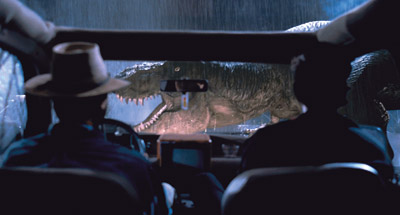 By size and scope, the most memorable Jurassic Park set was perhaps the Visitor's Center constructed on Stage 12, but it was closely rivalled by the T. rex Paddock, located on one of the largest sound stages at Warner Brothers Studios. Lantieri and his crew built the riggings that mobilised the 3,000 lb. dinosaur, who along with his fellow actors, worked long, hard hours in the wind, rain and mud.
By size and scope, the most memorable Jurassic Park set was perhaps the Visitor's Center constructed on Stage 12, but it was closely rivalled by the T. rex Paddock, located on one of the largest sound stages at Warner Brothers Studios. Lantieri and his crew built the riggings that mobilised the 3,000 lb. dinosaur, who along with his fellow actors, worked long, hard hours in the wind, rain and mud.
The film's climactic finale was filmed on Stage 12, in Jurassic Park's enormous Rotunda, which, according to the script, is still under construction. As John Hammond escorts his visitors into the main lobby, the first thing they see are two gigantic dinosaur skeletons displayed in the middle of the Rotunda.
Constructed by Toronto-based Research Casting International, the museum-quality pieces are full-size re-creations of a T. rex, which is approximately 40-feet long, and an Alamosaurus, which measures 45-feet long.
As the cast and crew lifted their glasses in a champagne toast on the final night of filming, a weary but enthusiastic Steven Spielberg announced that Jurassic Park, an ambitious project which had been two years in the planning and four months before the cameras, had finished on budget and 12 days ahead of schedule.
MORE





